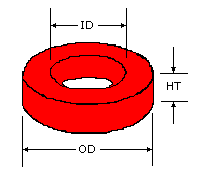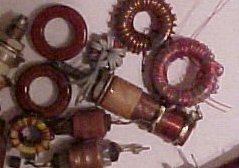


These come in two types. Powdered Iron or Ferrites. Both introduce permeability. Toroids look exactly like doughnuts and come in various diameters, thicknesses, permeabilities and types depending upon the requency range of interest. Note the correct spelling, not torroids
1. High inductance for the physical space occupied.
2. No interaction or coupling with adjacent components (unlike air wound and other inductors).
3. Various permeabilities are available.
4. Exceptional Q values when wound correctly and optimum core and windings selected.
5. Wide range of diameters and thicknesses.
6. Relatively low cost
7. Often simple to mount or secure mechanically.
1. Nearly impossible to introduce variable tuning of the inductance.
2. Subject to some thermal drift.

Fig 1. - Toroid Core
A typically popular type is made available by Micrometals and a representative example is the T50-2. This core is lacquered red (so you know the type) and has the following main properties.
Being T50 it's outside diameter is 0.5", the ID is 0.3" and the thickness is 0.19"
The permeabilities or in this case AL factors i.e. ( inductance per 100 turns2 ) are:
TYPE COLOR AL Freq. Range
T50-26 Yel-Wh
320uH
power freq.
T50-3 Gray
175
50 Khz to 500 Khz
T50-1 Blue
100
500 Khz to 5 Mhz
T50-2 Red
57
2 Mhz to 30 Mhz
T50-6 Yellow
47
10 to 50 Mhz
T50-10 Black
32
30 to 100 Mhz
This is only a small sample to give you an idea. Your turns required to give a certain inductance based on the above AL is as follows:
N = 100 * Ö[ L / AL]
Therefore to obtain an inductance of 3.685 uH using a T50-6 toroid would require 28 turns (of course I cheated again) but check it out on your calculator as I may have left in a deliberate mistake to see if you're awake.
By the way don't get too paranoid about the exact number of turns because cores do vary in value anyway and particularly with temperature changes.
I finally got around to photographing some coils and toroids.

Figure 2 - photograph of some coils and toroids
Sorry for the poor lighting. The top two toroids on the left are T68-2 types (red). Below that is the yellow T50-6 type. To the right of the yellow toroid are two RFC (radio frequency chokes) one is 1 mH and the other is 2.5 mH. Above the RFC, lying diagonally, is a 4.7 uH (nominal) variable inductor from J.W. Miller. At the extreme left of the photo is the tip of a similar variable inductor where the tuning screw is a little more clearer.
Finally to the middle right is a wound toroid I salvaged from somewhere.
FREE Micrometals RF design software, RF-Toroid was written as a supplement to the Micrometals RF Application catalog. Much emphasis was put into calculating the location of the Self resonate frequencies for series and shunt inductors. RF-Toroid is for use DC to 300 MHz. Much research went in to the calculation and corrections from the standard formulas for low perm & phenolic cores to better predict the RF style of winding and application.
Some features include SRF for series and shunt cores, peak Q curve ranges and 200 & 360 degree coverage to achieve the best product possible for the microwave designer who needs accurate and abundant information at the finger tips to compare one core to another simultaneously. The custom core feature allows for custom shaped cores, stacking cores side by side , ferrite cores and machining custom phenolic cores from plastic, wood, ect... Micrometals hope this tool will serve you well.
Download Micrometals RF Design Software - 397Kb
Go to Micrometals Inductor Design Software for other inductor software.
PLEASE NOTE:The toroid part numbers mentioned herein and elsewhere on my sites are copyright © Micrometals, Inc.